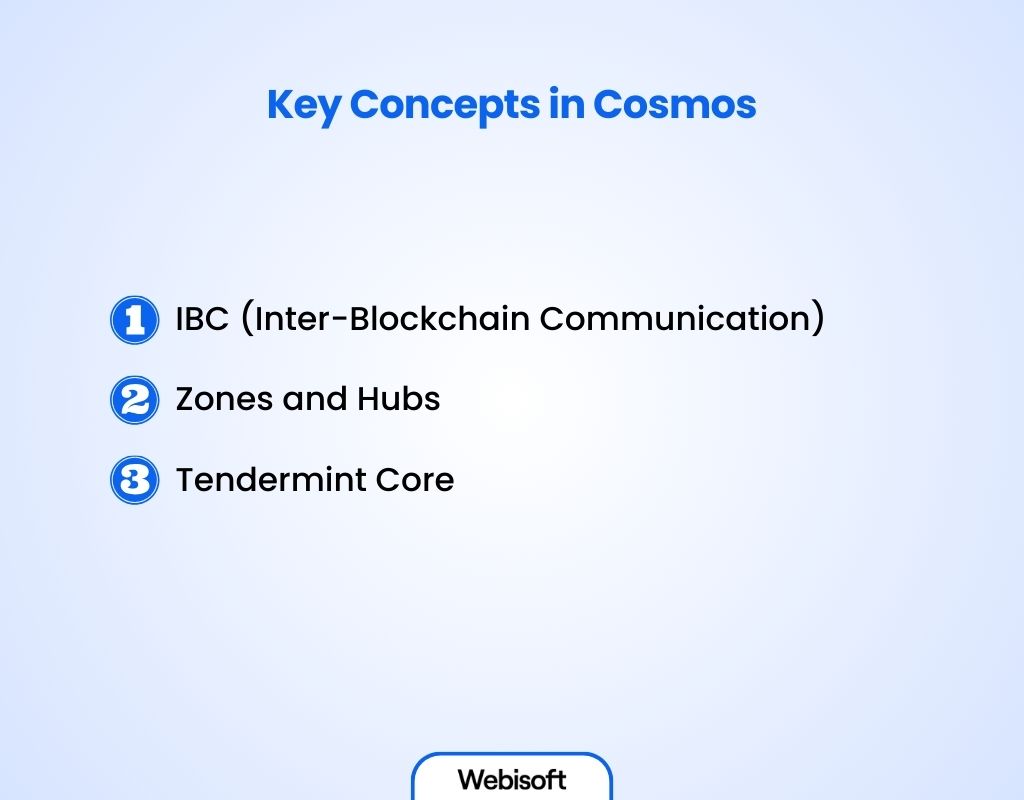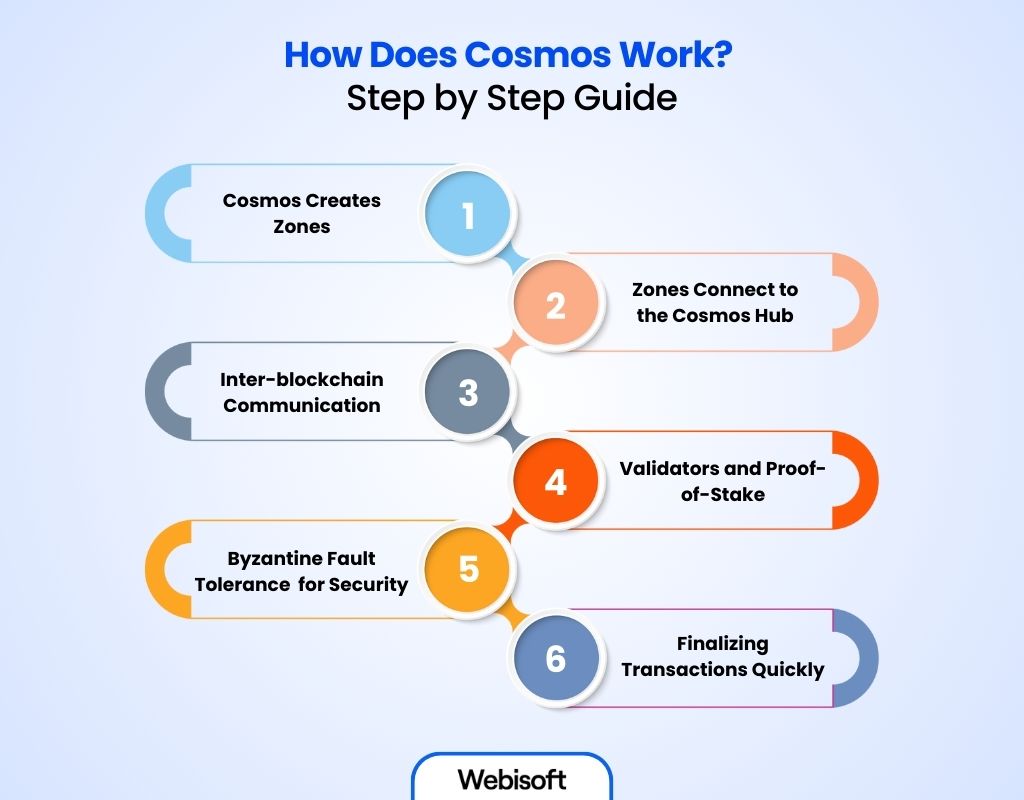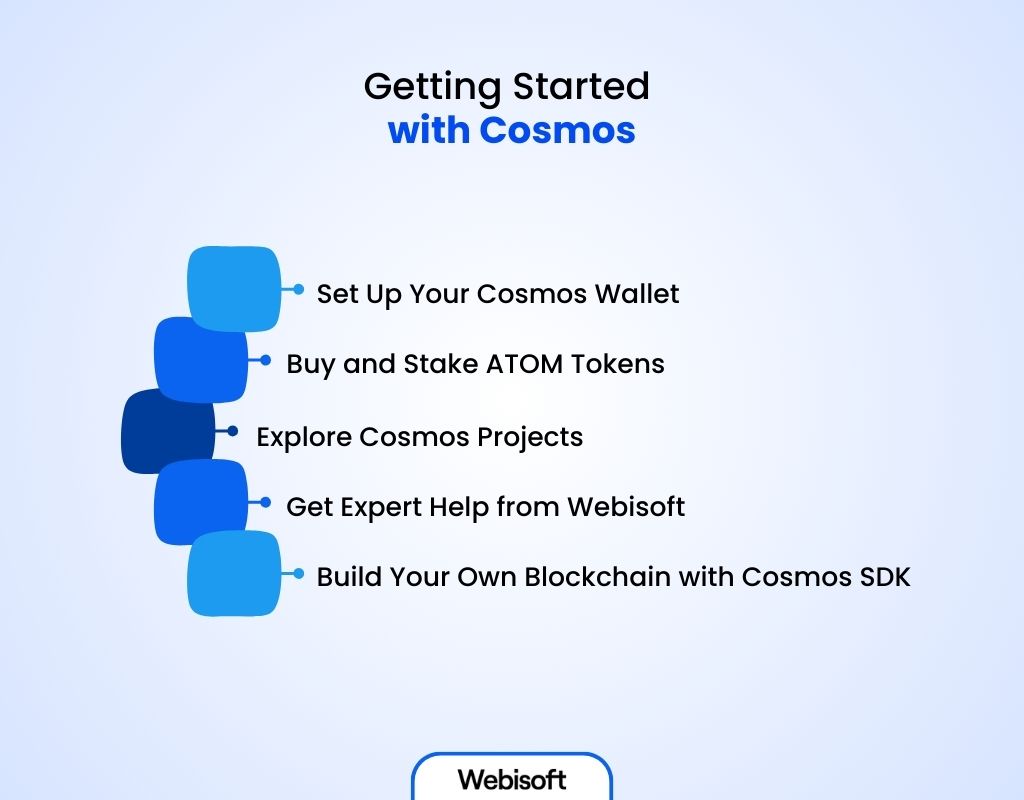Cosmos is a platform that addresses major blockchain challenges. It solves problems like scalability and interoperability.
But how does the Cosmos work? Cosmos connects different blockchains using the Inter-Blockchain Communication (IBC) protocol, which allows blockchains to share data and values easily.
It also uses a consensus mechanism called Tendermint to ensure security and speed.
In this guide, we’ll break down how Cosmos works step by step. By the end, you’ll see how it builds a decentralized network where blockchains can work together.
Contents
- 1 Key Concepts in Cosmos
- 2 How Does Cosmos Work? Step by Step Guide
- 2.1 Step 1: Cosmos Creates Zones (Independent Blockchains)
- 2.2 Step 2: Zones Connect to the Cosmos Hub
- 2.3 Step 3: Inter-blockchain Communication (IBC)
- 2.4 Step 4: Validators and Proof-of-Stake (PoS)
- 2.5 Step 5: Byzantine Fault Tolerance (BFT) for Security
- 2.6 Step 6: Finalizing Transactions Quickly (Fast Finality)
- 3 Cosmos Architecture Breakdown
- 4 Examples of Cosmos Projects
- 5 Getting Started with Cosmos
- 6 Conclusion
- 7 FAQs
Key Concepts in Cosmos

Cosmos lets different blockchains work together. It solves problems like security, growth, and communication. It has three main parts: IBC, Zones and Hubs, and Tendermint Core. Let’s explain them one by one.
IBC (Inter-Blockchain Communication)
IBC lets blockchains talk to each other. Without IBC, blockchains would be like separate islands. IBC connects these islands so that they can share data and tokens.
- How it works: IBC sends data in small pieces called packets. These packets carry things like tokens or messages.
- Relayers: Special nodes, called relayers, move these packets from one blockchain to another.
- Data checks: Before sending data, IBC makes sure it’s correct. This stops any mistakes or bad data.
Zones and Hubs
Cosmos uses zones and hubs to organize the blockchains.
- Zones: A zone is a blockchain with its own rules. It works by itself. For example, one zone could be for finance, and another could be for games. Zones control themselves and do whatever they want.
- Cosmos Hub: The Cosmos Hub is the main blockchain. It connects all the zones like a bridge. The Cosmos Hub doesn’t control the zones, but it helps them communicate. The Hub uses ATOM, its own token, for voting and security.
Tendermint Core
Tendermint Core enables the Cosmos network to agree on what is happening. It makes sure everyone agrees on valid transactions. It uses two main systems: Byzantine Fault Tolerance (BFT) and Proof-of-Stake (PoS).
- Byzantine Fault Tolerance (BFT): BFT ensures that the network keeps working even if some nodes (computers) are bad. The system can still run if up to one-third of the nodes fail or cheat.
- Proof-of-Stake (PoS): In Proof-of-Stake, people called validators check transactions. Those with more ATOM tokens have a higher chance, but cheating makes them lose tokens.
- Fast finality: Once a block is added, it is final right away. This makes the network fast and secure.
How Does Cosmos Work? Step by Step Guide

Cosmos is a network that connects many blockchains so they can work together. It’s made up of several parts that allow these blockchains to stay secure, communicate, and grow. Let’s go through the steps of how Cosmos works.
Step 1: Cosmos Creates Zones (Independent Blockchains)
Cosmos starts by creating zones.
Each zone is a separate blockchain that operates by itself. It can have its own rules, design, and goals. For example, one zone may be designed for finance while another can be used for gaming. Each zone works independently to focus on its area.
Zones help Cosmos handle more work and transactions.
Since each zone works on its own, Cosmos can grow without slowing down. More zones mean more blockchains can run in parallel, increasing the speed and efficiency of the entire system.
Step 2: Zones Connect to the Cosmos Hub
Zones need to communicate with each other. This is where the Cosmos Hub comes in.
The Cosmos Hub is the main blockchain that connects all the zones together. It does not control the zones but supports them in talking to one another and sharing information.
The Hub allows the zones to send data, tokens, and messages to each other. It acts as a central point where all zones connect and interact. The Cosmos Hub uses ATOM, a cryptocurrency, to secure the network and let users vote on important decisions.
Step 3: Inter-blockchain Communication (IBC)
To send data between zones, Cosmos uses IBC (Inter-Blockchain Communication). IBC is a set of rules that lets different blockchains communicate. It sends data in small packets, including tokens or other information.
Relayers are special nodes that transport these packets. They make sure the data reaches the correct zone. IBC lets Cosmos zones work together and share information, even though each zone has its own rules.
It ensures smooth communication between different blockchains.
Step 4: Validators and Proof-of-Stake (PoS)
Cosmos uses Proof-of-Stake (PoS) for security. In PoS, validators are selected to check transactions. Validators are chosen based on how many ATOM tokens they have staked or locked up. The more tokens they stake, the more likely they are to become validators.
Validators check transactions and confirm they are correct. If they try to cheat or act wrongly, they lose their staked tokens. This system makes sure validators act honestly and keeps the network safe and reliable.
Step 5: Byzantine Fault Tolerance (BFT) for Security
This one is an important step of how the cosmos works.
Cosmos uses Byzantine Fault Tolerance (BFT) to keep the network secure.
BFT ensures the system continues working even if up to one-third of the nodes are faulty or dishonest. It allows the network to still agree on which transactions are valid, even if some nodes fail.
BFT makes Cosmos strong and trustworthy. It protects the network from bad actors breaking it. Even if some validators cheat or fail, the system can still function correctly, and the transactions remain secure.
Step 6: Finalizing Transactions Quickly (Fast Finality)
Once a transaction is approved, it’s finalized immediately. This means no one can change or cancel it after it’s added to the blockchain.
Cosmos uses fast finality, which makes sure that transactions are secure and permanent right away.
Cosmos connects independent blockchains for seamless communication; decentralized healthcare platforms are transforming patient access to medication. You can leverage secure digital frameworks to ensure privacy, reliability, and accessibility.
Cosmos Architecture Breakdown
Cosmos architecture helps you connect different blockchains. It lets each blockchain stay independent but still share information. The system is fast, secure, and scalable. Now, let’s look at the key parts of Cosmos architecture.
- Cosmos Hub: The Cosmos Hub is the main blockchain that connects all other blockchains, called zones. It uses ATOM tokens to keep the network secure and make decisions.
- Zones: Zones are separate blockchains with their own rules. They focus on things like finance or gaming. Zones are independent, but they communicate through the Cosmos Hub.
- Inter-Blockchain Communication (IBC): IBC is the protocol that lets you send data and tokens between blockchains. It makes sure data is transferred safely and securely.
- Tendermint Core: Tendermint Core helps validators (computers) agree on the state of the blockchain. It keeps transactions fast and secure for you.
- Validators: Validators are the computers that check transactions. They are picked based on how many ATOM tokens they have staked. You can become a validator by stacking tokens.
- Proof-of-Stake (PoS): PoS is a system where validators are picked based on how many ATOM tokens they lock up. This keeps the network safe and secure.
- Cosmos SDK: The Cosmos SDK is a set of tools for developers. It makes it easy to build custom blockchains for different uses.
- Governance: Cosmos lets you, as an ATOM token holder, vote on important decisions. This keeps control decentralized and gives you a voice in the network’s future.
Examples of Cosmos Projects
Cosmos is home to many exciting and innovative projects. These projects use Cosmos’ architecture to build scalable, interoperable, and secure blockchains.
The Cosmos ecosystem supports a wide variety of industries, from finance to gaming and beyond. Let’s take a look at some of the notable cosmos blockchain use cases in the Cosmos ecosystem:
| Project Name | Description | Industry | Key Features | Tokens/Assets |
| Cosmos Hub | The central blockchain that connects other blockchains (zones) in the ecosystem. | Blockchain | ATOM staking, cross-chain communication | ATOM |
| Binance Chain | A fast and secure blockchain for Binance’s cryptocurrency exchange. | Finance | Fast transactions, low fees | BNB |
| Terra | A decentralized finance platform with stablecoins for payments and savings. | Finance | Stablecoins (LUNA, UST), decentralized finance | LUNA, UST |
| Kava | A platform for cross-chain DeFi applications, including lending and borrowing. | DeFi | Multi-chain lending, staking, collateralized loans | KAVA, USDX |
| Secret Network | A blockchain that focuses on privacy for smart contracts and transactions. | Privacy/DeFi | Privacy-preserving smart contracts | SCRT |
| Crypto.org Chain | A blockchain built to offer fast and low-cost payments for cryptocurrency. | Payments | Fast transactions, low fees | CRO |
| Akash | A decentralized cloud computing platform that connects providers and users. | Cloud Computing | Decentralized cloud, server rentals | AKT |
| Persistence | A project focused on tokenized real-world assets, like real estate and NFTs. | Finance/NFT | NFT creation, tokenized real estate | XPRT |
| Osmosis | A decentralized exchange (DEX) that allows users to trade assets between blockchains. | DeFi | Liquidity pools, cross-chain asset trading | OSMO |
| Stargaze | A platform for creating and trading NFTs in a decentralized way. | NFTs | NFT minting, marketplace | STARS |
These are just a few examples of the projects built on the Cosmos network. Each one leverages Cosmos’ unique features to create solutions that are scalable, secure, and interconnected.
Getting Started with Cosmos

So now you know how Cosmos works, it’s time to get started!
Starting with Cosmos is easy, and it provides you with all the tools you need to either use the network or build your own blockchain.
Follow these 5 simple steps to get started:
Set Up Your Cosmos Wallet
First, choose a wallet like Keplr or Cosmostation to store your ATOM tokens. Download the wallet and follow the setup instructions carefully. Don’t forget to save your recovery phrase in a safe place to secure your wallet.
Buy and Stake ATOM Tokens
Buy ATOM tokens on major exchanges like Binance or Kraken. Once you have ATOM, stake it through your wallet to support network security. Choose a validator to stake your tokens and start earning rewards.
Explore Cosmos Projects
Explore different Cosmos-based projects like Osmosis, Terra, or Secret Network. These projects cover areas like DeFi, NFTs, and privacy. By engaging with them, you’ll learn more about the Cosmos ecosystem.
Get Expert Help from Webisoft
If you need assistance, Webisoft offers expert support with Cosmos. Whether you’re staking, building a blockchain, or exploring projects, Webisoft can guide you. Their team ensures you get the most out of the Cosmos ecosystem.
Build Your Own Blockchain with Cosmos SDK
Use the Cosmos SDK to build your own custom blockchain. The SDK offers ready-made modules to guide you in getting started easily. Customize the blockchain according to your needs, whether it’s for gaming, finance, or another use case.
Conclusion
So, you got a good idea of how Cosmos works and what it offers. Cosmos enables different blockchains to connect and work together smoothly. It keeps everything secure, fast, and able to grow.
Whether you’re using Cosmos, building blockchains, or exploring new projects, it has tools for you. With Cosmos, you can easily join the blockchain world and take advantage of its many features.
FAQs
What is Cosmos blockchain?
Cosmos is a network that connects blockchains to work together. It allows blockchains to stay independent but still share data and tokens. By doing so, it improves their efficiency and lets them grow without issues.
What is Cosmos Crypto?
Cosmos crypto refers to ATOM, the main cryptocurrency of the Cosmos network. ATOM helps secure the network and lets users participate in important decisions. By staking ATOM with validators, you can confirm transactions and earn rewards for your support.
How does Cosmos connect blockchains?
Cosmos connects blockchains using IBC (Inter-Blockchain Communication). IBC allows blockchains to send data and tokens to each other safely. It ensures secure communication, making it easy for different blockchains to share information and work together.
What is Cosmos Hub?
Cosmos Hub is the main blockchain that connects other blockchains, called zones. It keeps everything secure by using ATOM tokens. Also, it assists in making important decisions to ensure the network runs smoothly and effectively.
What is Cosmos SDK?
Cosmos SDK is a set of tools for developers to build custom blockchains. It makes it easier to create blockchains for different uses. Developers can use SDK to build specialized networks with ease, saving time and effort in the process.
How Does Cosmos Crypto Work?
Cosmos crypto, ATOM, works by securing the network. Users stake ATOM tokens with validators to confirm transactions. Validators keep the network safe. In return, users earn rewards. ATOM is also used to vote on important decisions and upgrades.
